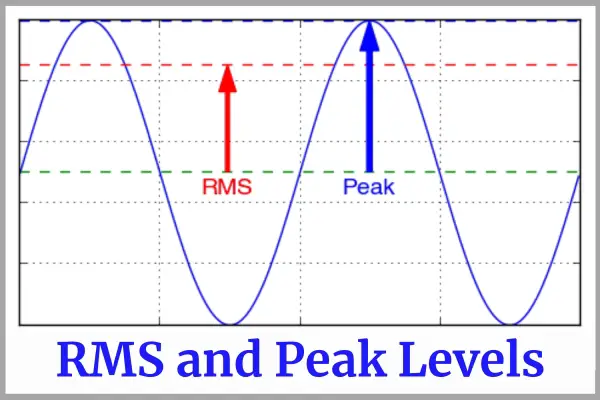What Does RMS Mean?
Audio production is a complex science and art form that requires a deep understanding of various technical concepts, one of which is Root Mean Square, or RMS, but what does it mean?
The term RMS is a statistical measure of the magnitude of a varying quantity and plays a crucial role in the world of audio. The understanding of RMS helps audio engineers to control and regulate the loudness and quality of the audio.
In this article, we will delve into the significance and mechanics of RMS in audio, elucidating why it’s so important to the field of sound engineering, and by the end of it, you’ll know exactly what RMS is…
Understanding the Basics
Before understanding what RMS means, it’s essential to grasp the basics of audio signals. Audio signals are a representation of sound that can be processed and manipulated by electronic devices, such as speakers.
They can be analog or digital, with analog being a continuous signal and digital being a discrete representation. These signals carry the information about the sound, such as its loudness and pitch.
The measurement of audio signals can be complex, as they are often ‘waveforms’ that fluctuate above and below a zero line. Because of this, audio engineers use various methods to measure these signals, aiming to capture different aspects of the audio.
Peak measurement, for example, identifies the maximum level of an audio signal, capturing the highest points of the waveform. RMS, on the other hand, is a different method that provides a more comprehensive picture of the audio signal’s loudness.
In the following sections, we will explore the concept of RMS in greater detail, highlighting its critical role in the world of audio production.

Understanding RMS in Detail
RMS, or Root Mean Square, is a statistical method that quantifies the magnitude of a varying signal. In the context of audio, it offers a useful measure of an audio signal’s perceived loudness.
Unlike peak level measurements which only capture the highest points of a waveform, RMS takes into account the entire waveform.
Mathematically, RMS is calculated by squaring all the values of the signal, finding the mean (or average) of those squared values, and then taking the square root of that mean.
This process provides a comprehensive view of the audio signal’s power, hence providing a measurement that aligns more closely with how humans perceive loudness.
RMS vs. Peak Power
Peak power is another important concept in audio. It identifies the maximum level that an audio signal reaches, i.e., the peaks of the waveform. This measure is crucial in avoiding signal distortion and clipping, which can occur if the signal exceeds the system’s maximum level.
However, peak power measurements may not always give a true representation of the perceived loudness of an audio signal. That’s because our hearing does not perceive loudness based on the instantaneous peak levels, but rather on an averaged, sustained level over a short period of time.
This is where RMS measurements become especially useful. By considering the entirety of the waveform and providing a kind of ‘average’ level, RMS gives a more accurate representation of the perceived loudness of the audio.
Therefore, while both RMS and peak power are important in audio production and engineering, they serve different purposes.
RMS gives us a better understanding of the perceived loudness, while peak level ensures we avoid distortion and maintain signal integrity. It’s the combination of these measures that helps audio professionals produce high-quality, well-balanced sound.

RMS in Audio Production
The role of RMS in audio production is central to the process of mixing and mastering. During mixing, engineers use the RMS values to balance the loudness levels between different tracks or instruments. This ensures that no one track overpowers the others and creates a consistent listening experience.
In mastering, the final stage of audio post-production, RMS is used to bring the track’s loudness to a target level suitable for its intended medium. For instance, a track being mastered for radio play may have a different target RMS value than one intended for streaming on digital platforms.
Understanding and properly utilizing RMS values can significantly impact the audio quality. In an era where listeners consume music on a wide array of devices and platforms, managing the RMS can ensure that the sound quality is maintained consistently across all playback scenarios.
And, the concept of RMS is crucial for managing dynamics in music. Audio with a high RMS value relative to its peak level is often described as being more ‘compressed’ or having less dynamic range, while audio with a lower RMS relative to its peak level has a greater dynamic range.
This relationship between RMS and dynamic range is another essential aspect that audio engineers take into account when aiming to produce a balanced and well-rounded sound.
What Does RMS Mean?
Understanding the concept of RMS in audio is indispensable for audio professionals and audiophiles aiming to create balanced, consistent, and high-quality audio content. RMS offers a more accurate representation of the perceived loudness of audio compared to other measurement methods, making it a critical tool in audio production, from mixing to mastering.
By carefully controlling and adjusting the RMS values, audio engineers can effectively manage the loudness and dynamics of their audio tracks, ensuring a pleasing and consistent listening experience across different devices and platforms. Additionally, the use of various tools to measure and adjust RMS values is essential to achieve the desired audio quality.
In a nutshell what does RMS mean: RMS stands as a cornerstone in the world of audio production. It’s not just about numbers and measurements—it’s about capturing and conveying the soul of the audio in a way that best resonates with the listener.

I am a passionate and skilled car audio enthusiast with 15 years of experience in the industry. My journey started when I replaced my first set of factory car speakers, sparking a deep love for high-quality sound. Since then, I have worked as a representative for renowned brands like Kenwood and Alpine.
With a background in both retail and distribution, I have developed a comprehensive understanding of the car audio market. Currently a certified (MECP) installer in the Mobile Electronics industry, my expertise lies in delivering top-notch audio installations. My knowledge, coupled with my genuine passion, makes me the go-to professional for all car audio needs.

